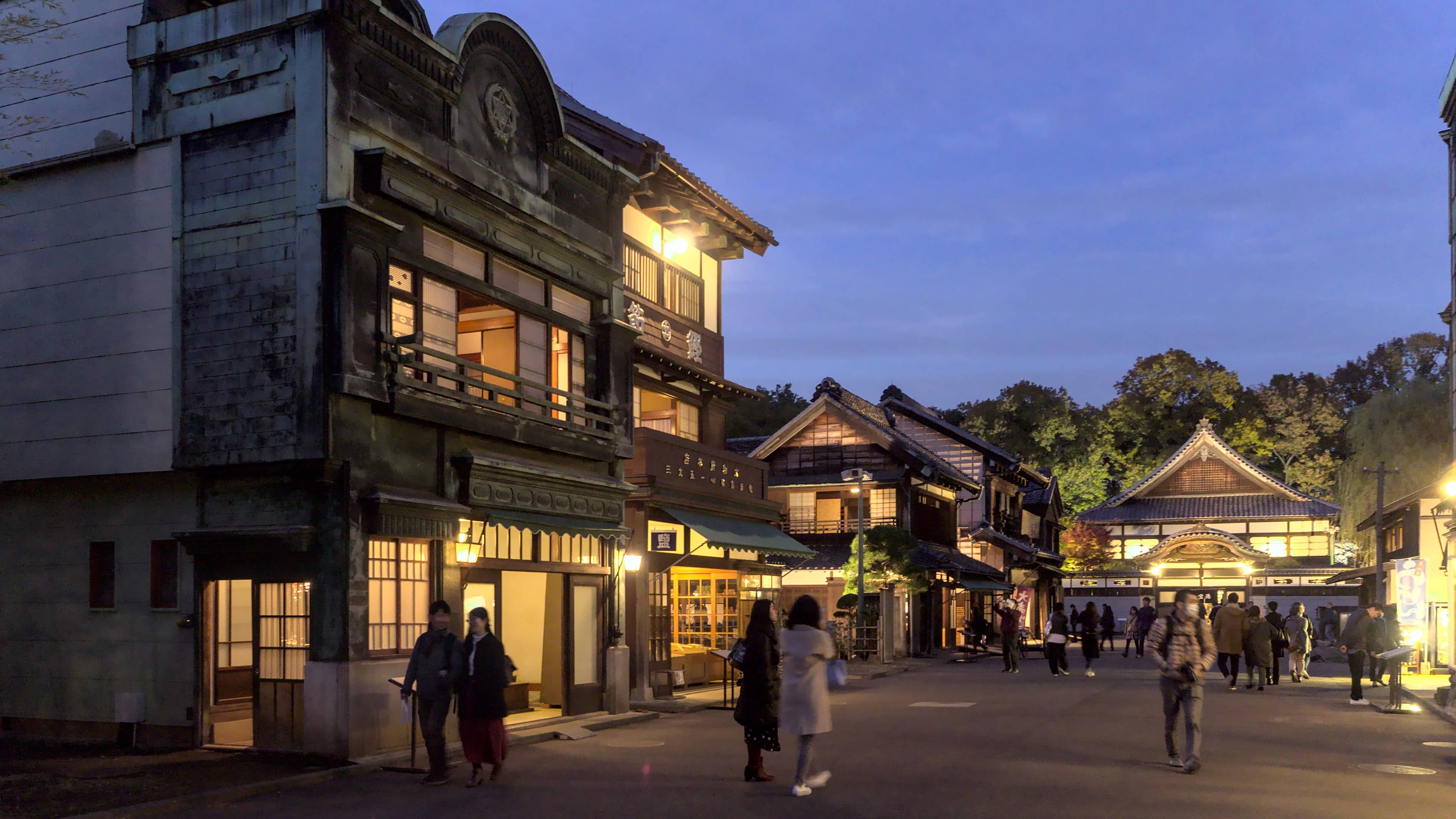
Edo-Tokyo Open Air Architectural Museum Tokyo
Step back in time at this open-air museum, showcasing preserved historical buildings from Edo to early Showa periods.

Highlights
Must-see attractions

Social
From TikTok & Reddit
Best Time
Fewer crowds, more peaceful exploration

Edo-Tokyo Open Air Architectural Museum Tokyo
Best Time
Fewer crowds, more peaceful exploration

Highlights
Must-see attractions
Step back in time at this open-air museum, showcasing preserved historical buildings from Edo to early Showa periods.
"A hidden gem offering a peaceful journey through Tokyo's architectural past."

👟 Wear Comfy Shoes!
The museum is spread out in a large park. You'll be doing a lot of walking to see all the buildings.
🎟️ Tickets On Arrival
No need to book in advance! Tickets are easily purchased at the entrance on the day of your visit.

Highlights
Discover the most iconic attractions and experiences

Edo Period Townhouses
Various locations within the museum
Wander through meticulously preserved merchant houses and shops, experiencing the atmosphere of old Tokyo.

Showa Era Residences
Various locations within the museum
Explore homes from the early 20th century, showcasing a different architectural era and lifestyle.

Traditional Bathhouse (Sento)
Various locations within the museum
Step inside a classic Japanese public bathhouse and imagine the social hub it once was.
Plans like a pro.
Thinks like you
Planning Your Visit
Embrace the Open Air
Beyond the Ghibli Vibes
Best Times
Insider Tips
from TikTok, Instagram & Reddit
👟 Wear Comfy Shoes!
The museum is spread out in a large park. You'll be doing a lot of walking to see all the buildings.
🎟️ Tickets On Arrival
No need to book in advance! Tickets are easily purchased at the entrance on the day of your visit.
📸 Photo Ops Galore
Great for photos, but avoid professional shoots without checking rules.
🕰️ Time Travel Experience
Offers a unique glimpse into historical Japanese architecture, distinct from Kyoto.
Tips
from all over the internet
👟 Wear Comfy Shoes!
The museum is spread out in a large park. You'll be doing a lot of walking to see all the buildings.
🎟️ Tickets On Arrival
No need to book in advance! Tickets are easily purchased at the entrance on the day of your visit.
📸 Photo Ops Galore
Great for photos, but avoid professional shoots without checking rules.
🕰️ Time Travel Experience
Offers a unique glimpse into historical Japanese architecture, distinct from Kyoto.
📍 Koganei Park Location
Located within the spacious Koganei Park, making for a lovely day out.
What Travellers Say
Reviews Summary
Visitors praise the Edo-Tokyo Open Air Architectural Museum as a unique and educational experience, offering a fascinating glimpse into Japan's architectural past. Many appreciate its peaceful atmosphere and the opportunity to explore historical buildings in a spacious park setting. Some note it's less crowded than other major attractions, making for a more relaxed visit.
"Really unique experience to see so many types of homes and shops over the ages, especially if you're interested in historical architecture. It's like going back in time or going to a movie set, but one you can kinda smell.
Strongly recommend you bring/wear sandals or flip flops, as most homes require you to take off your shoes. Fair and tolerable weather preferred sinces it's quite outdoor.
No need to make this a part of your whirlwind three days in Tokyo, but if you are here for a while, it's worth checking out. Tickets online or in person - super affordable, no wait, never too busy. Easy to get to and from by bus from the station."
Victor Chiu
"Absolutely amazing place and a must-visit! The Edo-Tokyo Open Air Architectural Museum left a great impression on me with its thoughtful display of historical buildings and everyday objects. It truly feels like stepping back in time. The immersive atmosphere and strong focus on both cultural and historical aspects make the experience unforgettable. A perfect spot for architecture lovers, history enthusiasts, and anyone looking to discover a different side of Japan."
Anna P
"A super day out! This place is worth the train and bus ride, very authentic feel, super staff and actors with lots of little activities and shows to keep you busy the whole day. We rented out costumes as a family and this added to our experience. It might be touristy but it is high quality touristy! Highly recommend!"
Lisanne Pinero
What People Like
What People Dislike
Frequently Asked Questions
🚇 🗺️ Getting There
The museum is located in Koganei Park. You can take the JR Chuo Line to Higashi-Koganei Station, which is about a 10-minute walk to the museum entrance.
Yes, it's accessible via train. The nearest station is Higashi-Koganei on the JR Chuo Line, making it a straightforward journey from major Tokyo hubs.
From Shinjuku Station, take the JR Chuo Line (Rapid) to Higashi-Koganei Station. The train ride is approximately 30-40 minutes, followed by a short walk.
Yes, there are parking lots available within Koganei Park, though they may fill up on busy days.
While the park grounds are generally accessible, some of the older buildings may have limited accessibility due to their historical nature. It's best to check with the museum directly for specific details.
🎫 🎫 Tickets & Entry
No, you generally do not need to buy tickets in advance. You can purchase them at the entrance on the day of your visit.
The museum is typically open from 9:30 AM to 5:30 PM, with last admission at 5:00 PM. It's always a good idea to check their official website for the most current hours, as they can vary seasonally.
Admission is usually very affordable, often around ¥400 for adults. Check the official website for the latest pricing information.
Discounts may be available for students, seniors, or groups. It's recommended to inquire at the ticket counter or check the museum's official website for details.
Yes, wearing a kimono is generally allowed and encouraged for visitors wanting to immerse themselves in the historical atmosphere. Just be mindful of rules regarding professional photography.
🎫 🏛️ Onsite Experience
You'll find a diverse collection of preserved buildings spanning from the Edo period (1603-1868) to the early Showa period (1926-1989), including merchant houses, farmhouses, a bathhouse, and a former police box.
While some visitors note 'Spirited Away' vibes, the Edo-Tokyo Open Air Architectural Museum is focused on historical architecture and daily life, not anime. It offers a different kind of immersive experience.
To fully explore and appreciate the museum, plan for at least 2-3 hours. If you want to relax and enjoy the park setting, you could easily spend half a day.
Guided tours may be offered in Japanese. Check the museum's schedule upon arrival or their website for availability and languages.
There is a cafe where you can rest and enjoy refreshments. Restrooms are also available throughout the park.
📸 📸 Photography
Photography is generally allowed inside the buildings for personal use. However, flash photography and professional photo shoots may be restricted.
Tripod usage might be restricted, especially during peak times or for commercial purposes. It's best to check the museum's specific photography guidelines.
Every corner offers a unique photo opportunity! The traditional streets, the bathhouse, and the various residential buildings provide excellent backdrops.
Personal vlogging is usually fine, but extensive filming or commercial video production might require special permission.
Some visitors find the atmosphere reminiscent of 'Spirited Away' due to the historical architecture and traditional settings, making it great for atmospheric photos.
For Different Travelers
Tailored advice for your travel style
👨👩👧 Families with Kids
Pack snacks and drinks, as while there's a cafe, having your own provisions can be convenient for younger children. Consider focusing on a few key buildings that might capture their imagination, like the bathhouse or the former shops. The open-air nature means you can easily take breaks and enjoy the park's greenery.
🚶♀️ Solo Travelers & Couples
Consider visiting on a weekday morning to enjoy the museum with minimal crowds, allowing for a more intimate experience. The museum's location in Koganei Park also provides a lovely setting for a relaxed outing, perhaps with a picnic or a visit to the on-site cafe.
🏛️ Architecture Enthusiasts
Pay close attention to the differences in materials, layouts, and decorative elements across the various eras. The museum provides a fantastic comparative study of Japanese architectural history, making it a deeply rewarding experience for enthusiasts.
Deep Dives
In-depth insights and expert knowledge
A Journey Through Tokyo's Architectural Past
Visitors often highlight the diversity of architectural styles on display. You can contrast the sturdy, traditional construction of Edo-period farmhouses with the more Western-influenced designs of Meiji-era homes and the distinct aesthetics of the Taisho and early Showa periods. This variety makes it a fascinating study for anyone interested in Japanese architecture and urban development. The museum's location within the expansive Koganei Park also adds to its appeal, offering a green oasis where you can enjoy a leisurely stroll and a picnic amidst historical structures.
Many find the museum to be a hidden gem and a welcome escape from the bustling city center. It's particularly recommended for those who appreciate history and architecture, offering a different perspective than the more commonly visited temples and shrines in Kyoto. The experience is often described as peaceful and educational, providing a quiet space to reflect on Tokyo's transformation over the centuries.
Practical Tips for Your Visit
When it comes to tickets, there's generally no need for advance booking. Unlike many popular Tokyo attractions, tickets for this museum can be easily purchased at the entrance on the day of your visit. This offers flexibility for your itinerary. The admission fee is also quite reasonable, making it an affordable option for a half-day excursion.
For photography enthusiasts, the museum offers abundant opportunities. The preserved buildings and traditional streetscapes provide picturesque backdrops. While personal photography is welcome, be aware of potential restrictions on professional shoots, commercial filming, and the use of tripods. Many visitors find the atmosphere evokes a sense of nostalgia and historical charm, with some even drawing comparisons to the enchanting world of Studio Ghibli films.






Social
from TikTok, Instagram & Reddit